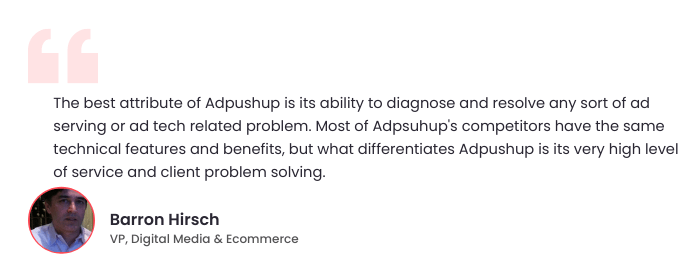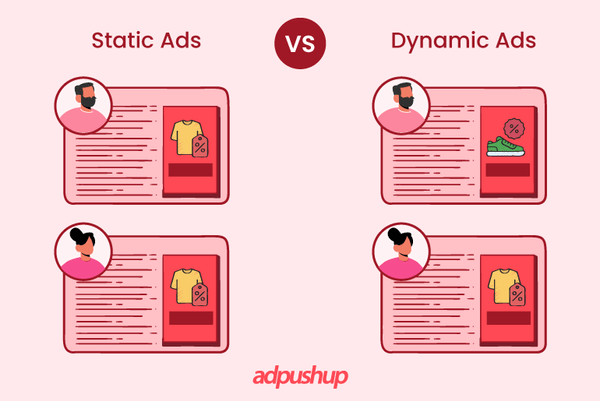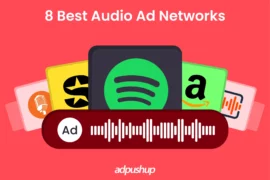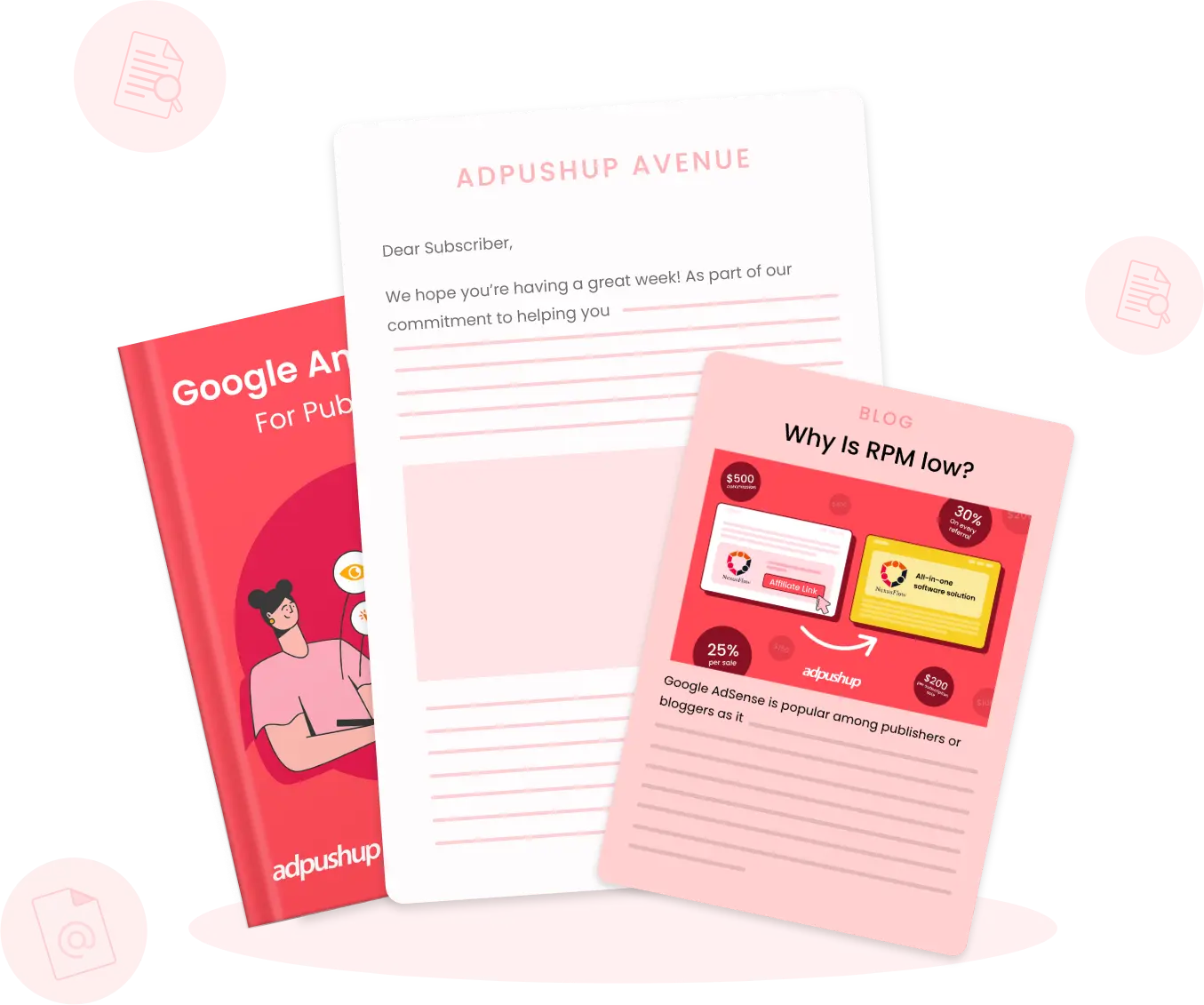Looking to explore the differences, pros, and cons of static vs dynamic ads? Our comprehensive guide covers everything you need to know about static vs dynamic ads. Take a look.
Publishers and marketers strive to reach far and wide audiences or target a specific audience, depending on their ad strategy, and they want to do it effectively.
For that, they pay attention to minute details, various ad formats, and choose what’s best for the brand. We understand that high-quality ads get more ad impressions and clicks, and if targeted accurately, they prompt conversions.
One of the most important decisions we require to make is what sort of ads we shall display. Static vs dynamic ads get the most attention because these ads become the defining factors for client acquisition.
Effective static ads, when displayed accurately, can serve almost any purpose. However, most businesses rely on dynamic ads to target a specific group of audiences and retarget the lead. Let us read further to know more about static vs dynamic ads.
Static vs Dynamic Ads: Key Differences
| Feature | Static Ads | Dynamic Ads |
| Content | Fixed content for all viewers; no personalization | Variable content tailored to each viewer; high degree of personalization |
| Setup Complexity | Simple, quick to create and implement | Complex, requires integration with databases |
| Cost | Lower, less production effort | Higher, due to dynamic content generation |
| Performance Tracking | Basic analytics (clicks, impressions) | Advanced tracking (CTR, CPA, ROAS, ad engagement) |
| Relevance | Less relevant to individual users | Highly relevant to each user’s interests |
| Engagement | Lower user engagement potential | Higher engagement due to personalized content |
| Maintenance | Low, minimal updates required | Higher, requires regular updates for relevance |
| Usage Scenarios | Best for branding, simple campaigns | Best for e-commerce, retargeting, personalized offers |
| Ideal for | Smaller product range, brand awareness | Larger ad inventory, retargeting, specific offers |
| Load Time/Performance | Fast, lightweight (ideal for poor connectivity) | Slower, requires optimization to reduce page latency |
Now that we have an idea about static versus dynamic ads, let’s look at them in detail.
What are Static Ads?
Static ads are often misunderstood as dynamic ads; video ads, or banner ads with moving text and images. However, static ads are still static, even video ads fall into this category.
Static ads are the best way for publishers to create awareness about a brand among a large audience.
These ads are not focused on any specific group of people. Moreover, the best part about these ads is that static ads don’t require a lot of resources to create and are supported by almost all advertising networks.
Key Features of Static Ads
- Don’t change based on user behavior, location, or preferences
- Easy to create and implement
- Highly cost-effective for small-scale campaigns

Examples of Static Ads
1. Static social media ads on Instagram to promote products.
2. Static interstitial ads on a website.
3. Static print ads for Uber Eats.
Pros
Universality
Static ads reign supreme in universality. Their simplicity translates to easier creation and faster implementation, making them perfect for businesses of all sizes and across industries. They’re cost-effective due to lower technical barriers and potentially lower costs, all while offering design flexibility to craft creative messages that grab user attention.
Easy Adaptability
Most ad networks accept static ads for their hassle-free display on both desktop and mobile screens. Any type of business within any industry can make use of static ads effectively.
Highly Convenient
Static ads are convenient because they don’t require technical or creative expertise or a lot of time to create. It also doesn’t require any maintenance or regular updation because these ads are merely there to tell people about the advertiser’s brand.
Easily Controlled
You can easily control and manage static ads because little to no maintenance and change are required. Their content doesn’t need to be changed on a regular basis so that static ads can be easily controlled and managed.
Best for Small-Scale Publishers
Static ads are perfect for publishers who have a fixed or static purpose of showing the ad that involves no regular updating or any change in the ad format, content, or retargeting of the audience.
Cons
No Precise Targeting
The first and foremost drawback of a static ad is that it is only there to reach a wide audience and basically not target or prompt them into converting. It lacks interaction because users cannot respond to an ad that is fixed on the site/ app.
Limited Scope of Personalization
Static ads also lack creativity because they don’t need any. It limits any scope for personalization or customization as per the user’s interests.
How to use Static Ads?
Mostly appearing in the form of animation, image, video, text, or banner ads, static ads, it can bring in a lot of people to your landing page or app if implemented effectively. Static ads are most suitable for generic offers like – Festival Discounts or Gifts. One can use static ads for:
- Social Media Profiles
- eBooks
- Banners or PPC ads
- Landing pages on a website
- One-way webinars
How to get the most out of Static Ads?
Static ads are undoubtedly less obtrusive compared to many other ad formats. On top of that, it comes with a classic design, making the design process fun and interesting. But that’s not all that it takes to succeed with static ads.
There are certain tactics you need to keep in mind to get the maximum out of static ads. Have a look.
Ad Placements
To get the most out of static ads, place them either above the fold or in the sidebars for high visibility. It’s best to avoid placing them within the main content to create a clutter-free experience for the users.
Brand Awareness
It goes without saying that relevancy can be difficult to achieve since static ads are meant for a wider audience. Therefore, the static ad strategy should involve targeting the people who are yet to be introduced to the brand.
Offer Something to the Users
Offering something to the users can work wonders when it comes to increasing the number of clicks. When you have incentives to offer, it encourages the users to engage with your ad. These offers could include a coupon code, a chance to enter a contest, and much more.
What are Dynamic Ads?
We call these ads dynamic because their content varies depending on user behavior and other available data. Dynamic ads are created with the sole purpose of targeting a specific set of audiences and delivering a relevant message. These ads are responsive and require changes as per the viewer’s demand. In other words, dynamic ads are here to retarget a lead and prompt them to convert.
Key Features of Dynamic Ads
- Are data-driven and employ automation and machine learning to personalize ads
- Use algorithms to show the most relevant ad in the feed according to real-time updates
- Are responsive and hence can be displayed across platforms and devices
Examples of Dynamic Ads
1. Google dynamic display ads to promote products.
2. Dynamic ads are shown on social media, such as Snapchat, in this case.
3. Weather-triggered dynamic ads.
Pros
Interactive and Personalized
Dynamic ads vary depending on user behavior. The changes are based on data related to users’ interests, demands, the next step after seeing the ad, etc. The basic elements in dynamic ads are products, different styles, prices, and/or discounts.
Brand Loyalty
These ads bring in brand loyalty as the user gets to see relevant messages or content on these ads. For example, if your shopping cart has an item and you haven’t yet purchased it, the brand will show the user ads related to discounts on the same item to prompt them to complete the purchase. The user will most likely visit the brand again.
Cons
Highly Expensive
Dynamic ads are expensive compared to static ads as they require more resources to create and set up. This can be an inconvenience for advertisers with a limited budget or no dedicated technical team.
Demands Efforts
Dynamic ads need technical, creative, and innovative expertise and regular changes in the content. It also requires exceptional time and effort to bring relevant content to the users.
How to get the most out of Dynamic Ads?
Since dynamic ads have much more to offer than static ads, they take more time to be created. These types of ads are capable of handling many types of complex functionalities. Let’s take a look at a few practices to help you make the most out of it.
Audience Segmentation
Unlike static ads, which are less customizable, dynamic ads allow you to target different audience groups. You can segment the audience into different groups based on demographics, interests, and behaviors. This will enable you to create target ads in a personalized manner to resonate with each segment.
A/B Test
As a publisher, you can A/B test various ad placement for dynamic ads to create a smooth user experience. Experiment with above the fold or side placements. You can even place them within the content as users would find them less-intrusive due to their eye-catchy details.
Scalable Personalization
Another practice for dynamic ads is to leverage their scalability to create and serve a large number of personalized ads to a wide audience. This can help to increase brand reach and awareness while driving more targeted traffic to the brand’s website.
To implement this practice, businesses should use data to create personalized ad content based on factors such as location, interests, behavior, and demographics. They should also use automation tools and dynamic creative optimization (DCO) to create and serve these ads at scale while monitoring their performance to make adjustments as needed.
Static vs Dynamic Ads: Which one should Publishers Choose?
There’s no right/wrong or one-word answer to choosing – static vs dynamic ads. Small-scale publishers may find static ads most convenient and easy to go for, whereas publishers offering a variety of services or goods can opt for dynamic ads.
The following are a few more criteria that you can consider while choosing dynamic vs static ads.
Understand your Campaign Goals
Static ads are best used for broad brand awareness campaigns and target users who have not been exposed to the brand before. Their static nature gels well with a simple and clear messaging format, making it easy for readers to understand the message at a glance.
On the other hand, you can deploy dynamic ads for complex storytelling. As dynamic ads can be personalized, they can be used for retargeting or product-specific messaging to drive conversions.
Analyze your Audience
Static ads work best for the general audience as no targeting is required in this case. However, it will be wise to choose dynamic ads if you have created targeted segments for your audience based on behavior, interests, etc.
Data Availability
There’s a popular saying: Data is the new currency. And this couldn’t be truer for the AdTech industry. If you are starting with programmatic advertising or currently don’t have much user data, opt for static ads. Not only will they create brand awareness, but they will also help in creating a user database.
On the other hand, once you have created a detailed user profile, you can switch to dynamic ads to target the target audience. Using the data, dynamic ads will show personalized ads to the users and drive conversions.
Industry and Niche
The usage of static or dynamic ads also depends on your niche or the industry you are currently in. For example, the e-commerce industry thrives on dynamic ads as they need to show ads based on updated or real-time user data for conversions.
However, small businesses or the service industry may find static ads more practical, as brand awareness is a major concern in most cases.
Static vs Dynamic Ads: Conclusion
The Static vs dynamic ads are an important choice to make as they directly impact the business. What type of ads you are displaying on your site or app affects the conversion of leads. It means that it’s the business’s needs, nature, and demands that help a publisher go for a certain ad format.
Grow your ad revenue by up to 40% with a Google Certified Publishing Partner. Sign up here for the free website monetization consulting.
FAQs on Static vs Dynamic Ads
Static banner ads are ads that do not change and are there to create brand awareness amongst a vast audience. Dynamic banner ads are ads that change as per the user’s behavior. These include content on products, prices, and discounts. Static ads are usually suitable for generic offers, while dynamic ads are suitable for specific ad campaigns.
A feature within Google AdWords, dynamic display ads are the ads shown dynamically to users depending upon the products they have browsed or the content they consume on the websites.
Static banner ads are ads with content that doesn’t need to be changed over time. Once assembled, these ads are easily maintained and controlled and with relatively low time and effort commitment.








